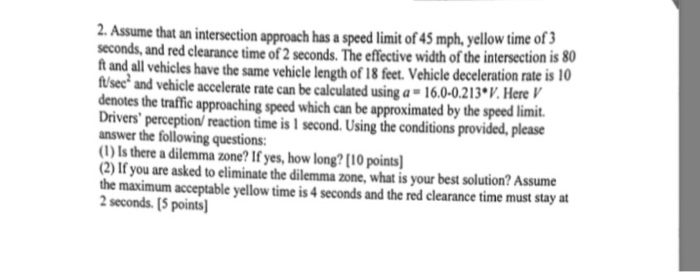QQuestionAnatomy and Physiology
QuestionAnatomy and Physiology
2. Assume that an intersection approach has a speed limit of 45 mph , yellow time of 3 seconds, and red clearance time of 2 seconds. The effective width of the intersection is 80 ft and all vehicles have the same vehicle length of 18 feet. Vehicle deceleration rate is 10 $\mathrm{ft} / \mathrm{sec}^{2}$ and vehicle accelerate rate can be calculated using $a= 16.0 - 0.213 * V$. Here $V$ denotes the traffic approaching speed which can be approximated by the speed limit. Drivers' perception/ reaction time is 1 second. Using the conditions provided, please answer the following questions:
(1) Is there a dilemma zone? If yes, how long? [10 points]
(2) If you are asked to eliminate the dilemma zone, what is your best solution? Assume the maximum acceptable yellow time is 4 seconds and the red clearance time must stay at 2 seconds. [5 points]
Attachments

6 months agoReport content
Answer
Full Solution Locked
Sign in to view the complete step-by-step solution and unlock all study resources.
Step 1: Determine the dilemma zone length
d_{dilemma} = d_{reaction} + d_{yellow} = 61.67 \ \text{feet} + 155 \ \text{feet} = 216.67 \ \text{feet}
The dilemma zone is the region where drivers may not be able to decide whether to stop or go through the intersection when the light turns yellow. It is the distance covered by a vehicle during the driver's perception/reaction time (1 second) and the yellow light time (3 seconds). First, calculate the distance covered during the perception/reaction time: where Next, calculate the distance covered during the yellow light time: where Now, calculate the total dilemma zone length: Since the effective width of the intersection is 80 feet, and the dilemma zone length is 216.67 feet, there is a dilemma zone.
Step 2: Eliminate the dilemma zone
Since the maximum acceptable yellow time is 4 seconds, we can set $t_{yellow}^{'} = 3.7 \ \text{seconds}$.
To eliminate the dilemma zone, we need to adjust the yellow light time so that the total distance covered during the perception/reaction time and the yellow light time is greater than the effective width of the intersection. Then,
Final Answer
(1) The dilemma zone is 216.67 feet long. (2) To eliminate the dilemma zone, adjust the yellow light time to 3.7 seconds.
Need Help with Homework?
Stuck on a difficult problem? We've got you covered:
- Post your question or upload an image
- Get instant step-by-step solutions
- Learn from our AI and community of students